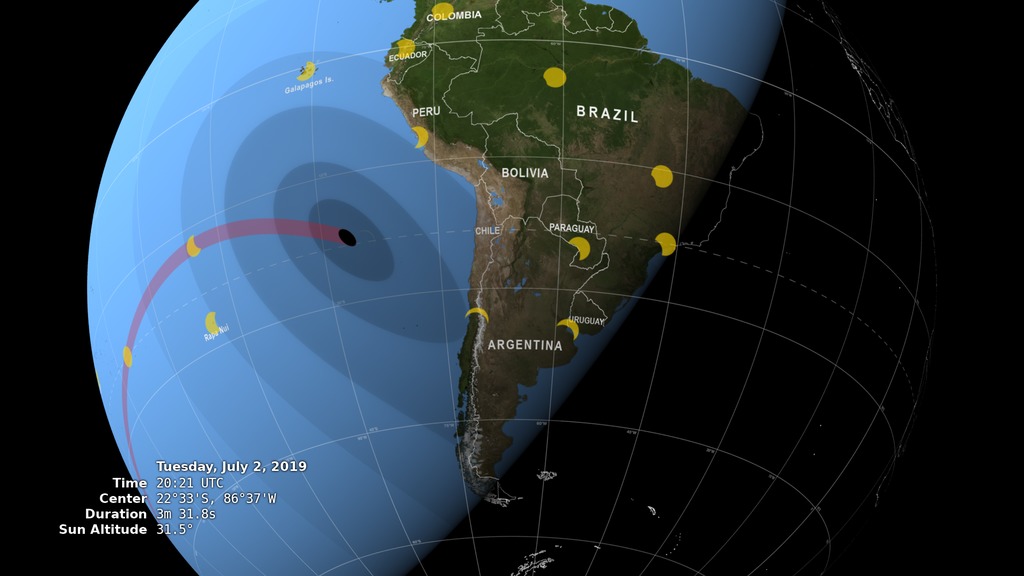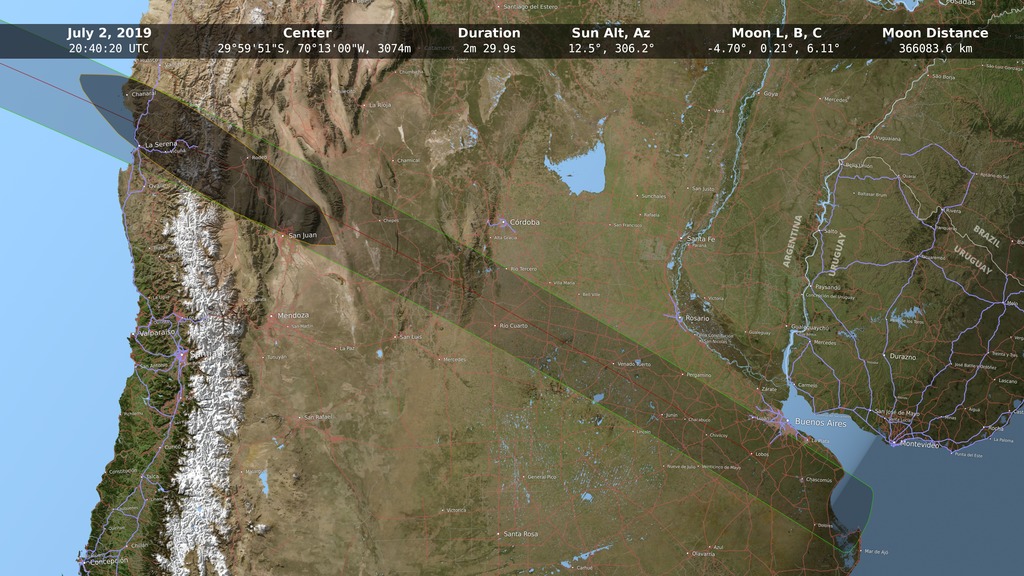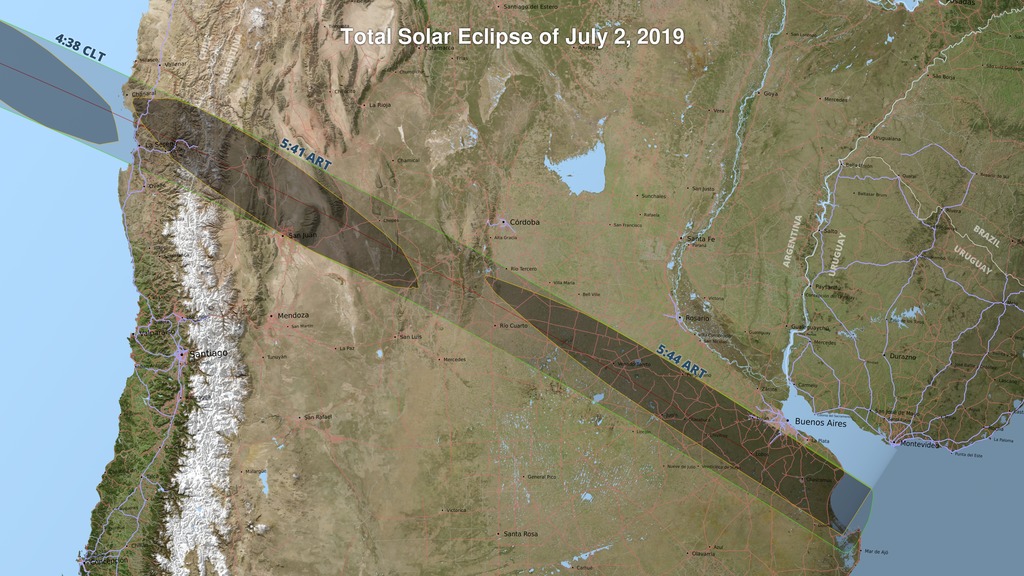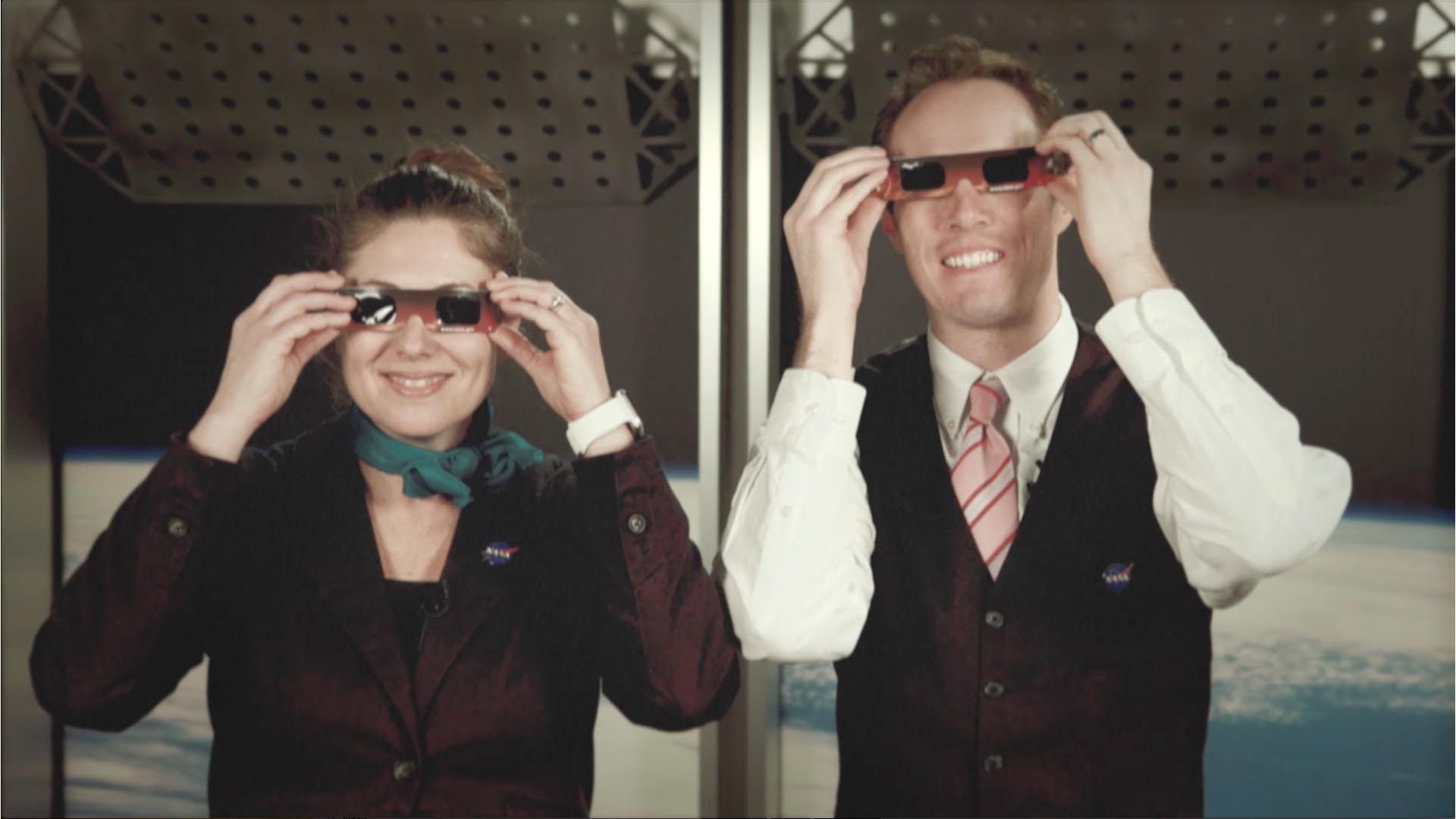Solar Eclipse 2019
Overview
On Tuesday, July 2, 2019, the Moon will pass in front of the Sun, casting its shadow across South America and the southern Pacific Ocean.
2019 Eclipse Path
2019 Path of Totality
Go to this pageThis animation shows the Moon's umbra shadow as it passes over Chile and Argentina during the July 2, 2019 total solar eclipse. Through the use of a number of NASA datasets, notably the global elevation maps from Lunar Reconnaissance Orbiter, the shape and location of the shadow is depicted with high accuracy. || eclipse.0320_print.jpg (1024x576) [213.0 KB] || eclipse.0320_searchweb.png (320x180) [106.4 KB] || eclipse.0320_thm.png (80x40) [7.0 KB] || eclipse_1080p30.mp4 (1920x1080) [16.3 MB] || eclipse_720p30.mp4 (1280x720) [8.4 MB] || eclipse_720p30.webm (1280x720) [2.5 MB] || eclipse_2160p30.mp4 (3840x2160) [45.9 MB] || eclipse_360p30.mp4 (640x360) [2.4 MB] || 3840x2160_16x9_30p (3840x2160) [0 Item(s)] || 2019-path-of-totality-4K.hwshow [250 bytes] || eclipse_1080p30.mp4.hwshow [181 bytes] ||
2019 Total Solar Eclipse Maps and Shapefiles
Go to this pageA map of Chile and Argentina showing the path of totality for the July 2, 2019 total solar eclipse. || tse2019_map_print.jpg (1024x576) [205.7 KB] || tse2019_map_searchweb.png (320x180) [104.2 KB] || tse2019_map_thm.png (80x40) [6.8 KB] || tse2019_map.tif (5760x3240) [28.7 MB] || tse2019_mapbase.tif (5760x3240) [28.8 MB] || 2019-total-solar-eclipse-map.hwshow [244 bytes] ||
How to watch
How to View the Solar Eclipse with a Pinhole Projector
Go to this pageMusic credit: Apple of My Eye by Frederik WiedmannWatch this video on the NASA Goddard YouTube channel.Complete transcript available. || 12638_How_to_Make_a_Pinhole_ProjectorV3_QT.H264.2997.00039_print.jpg (1024x576) [65.1 KB] || 12638_How_to_Make_a_Pinhole_ProjectorV3_QT.H264.2997.00039_searchweb.png (320x180) [45.1 KB] || 12638_How_to_Make_a_Pinhole_ProjectorV3_QT.H264.2997.00039_thm.png (80x40) [5.3 KB] || 12638_How_to_Make_a_Pinhole_ProjectorV3_QT.H264.2997.mov (1920x1080) [40.8 MB] || 12638_How_to_Make_Pinhole_ProjectorV3_AppleTV540.mp4 (960x540) [10.9 MB] || 12638_How_to_Make_Pinhole_ProjectorV3_H264.2997.mp4 (1920x1080) [77.4 MB] || 12638_How_to_Make_a_Pinhole_ProjectorV3_QT.H264.2997.webm (1920x1080) [8.9 MB] || 12638_How_to_Make_Pinhole_ProjectorV3_YouTube1080p.mp4 (1920x1080) [116.4 MB] || 12638_How_to_Make_a_Pinhole_Projector.en_US.srt [1.0 KB] || 12638_How_to_Make_a_Pinhole_Projector.en_US.vtt [1.0 KB] || 12638_How_to_Make_Pinhole_ProjectorV3_APR5994.mov (1920x1080) [2.1 GB] ||
How to Safely Watch a Solar Eclipse
Go to this pageIt is never safe to look directly at the sun's rays – even if the sun is partly obscured. When watching a partial eclipse you must wear eclipse glasses at all times if you want to face the sun, or use an alternate indirect method. This also applies during a total eclipse up until the time when the sun is completely and totally blocked.During the short time when the moon completely obscures the sun – known as the period of totality – it is safe to look directly at the star, but it's crucial that you know when to take off and put back on your glasses.First and foremost: Check for local information on timing of when the total eclipse will begin and end. NASA's page of eclipse times is a good place to start. Second: The sun also provides important clues for when totality is about to start and end.Learn more at https://eclipse2017.nasa.govFind more videos about the solar ecilpse on the Sun Eclipse 2017 gallery page. ||
Watching the Friendly Skies - Eclipse Safety Tutorial
Go to this pageMusic Credit: Chic to Chic by Piero PiccioniWatch this video on the NASA Goddard YouTube channel.Complete transcript available. || safetyThumbnail.jpg (1920x1080) [115.2 KB] || safetyThumbnail_searchweb.png (320x180) [92.4 KB] || safetyThumbnail_thm.png (80x40) [7.7 KB] || 12517_eclipse_safety_wpost.webm (1920x1080) [24.0 MB] || TWITTER_720-12517_eclipse_safety_wpost_VX-691382_twitter_720.mp4 (1280x720) [45.5 MB] || 12517_eclipse_safety_wpost.mp4 (1920x1080) [211.6 MB] || FACEBOOK_720-12517_eclipse_safety_wpost_VX-691382_facebook_720.mp4 (1280x720) [259.9 MB] || YOUTUBE_1080-12517_eclipse_safety_wpost_VX-691382_youtube_1080.mp4 (1920x1080) [346.3 MB] || YOUTUBE_720-12517_eclipse_safety_wpost_VX-691382_youtube_720.mp4 (1280x720) [347.9 MB] || 12517_eclipse_safety_wpost.en_US.srt [3.8 KB] || 12517_eclipse_safety_wpost.en_US.vtt [3.8 KB] || 12517_eclipse_safety_wpost_VX-691382_lowres.mp4 (480x272) [28.3 MB] || NASA_PODCAST-12517_eclipse_safety_wpost_VX-691382_ipod_sm.mp4 (320x240) [40.1 MB] || 12517_eclipse_safety_wpost.mov (1920x1080) [5.1 GB] ||
Learn about eclipses
What determines when we have an eclipse?
Go to this pageMusic: Witch Waltz by Dorian KellyComplete transcript available.Watch this video on the NASA Goddard YouTube channel. || EclipsePlane_V7.00001_print.jpg (1024x576) [79.6 KB] || EclipsePlane_V7.00001_searchweb.png (320x180) [62.0 KB] || EclipsePlane_V7.00001_thm.png (80x40) [3.8 KB] || EclipsePlane_V7.mp4 (1920x1080) [63.0 MB] || EclipsePlane_V7_1.mp4 (1920x1080) [91.4 MB] || EclipsePlane_V7.webm (1920x1080) [5.7 MB] || EclipsePlane_V7.en_US.srt [499 bytes] || EclipsePlane_V7.en_US.vtt [511 bytes] || EclipsePlane_V7.mov (1920x1080) [1.6 GB] ||
A Total Solar Eclipse Revealed Solar Storms 100 Years Before Satellites
Go to this pageEclipses set the stage for historic science. NASA is taking advantage of the Aug. 21, 2017 eclipse by funding 11 ground-based scientific studies. As our scientists prepare their experiments for next week, we're looking back to an historic 1860 total solar eclipse, which many think gave humanity our first glimpse of solar storms — called coronal mass ejections — 100 years before scientists first understood what they were.Scientists observed these eruptions in the 1970s during the beginning of the modern satellite era, when satellites in space were able to capture thousands of images of solar activity that had never been seen before. But in hindsight, scientists realized their satellite images might not be the first record of these solar storms. Hand-drawn records of an 1860 total solar eclipse bore surprising resemblance to these groundbreaking satellite images.Eclipse archive imagery from: http://mlso.hao.ucar.edu/hao-eclipse-archive.php ||







![Complete transcript available.Music credits: ‘Electricity Wave’ by Jean-François Berger [SACEM] and ‘Solar Winds’ by Ben Niblett [PRS], Jon Cotton [PRS]Watch this video on the NASA Goddard YouTube channel.](/vis/a010000/a012600/a012693/LARGE_MP4-12693_FirstCMEDuringEclipse_large.00139_print.jpg)